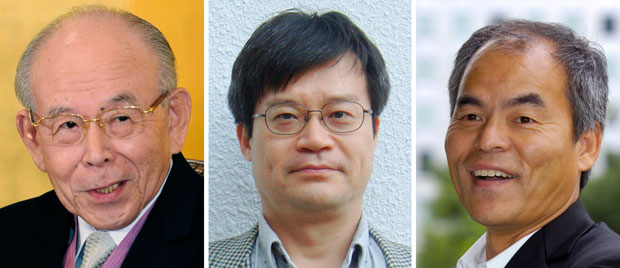STOCKHOLM ( MEDIA )
An invention that promises to revolutionize the way the world lights its homes and offices — and already helps create the glowing screens of mobile phones, computers and TVs — earned a Nobel Prize in physics Tuesday for two Japanese scientists and a Japanese-born American.
By inventing a new kind of light-emitting diode, a blue LED, they overcame a crucial roadblock for creating white light far more efficiently than incandescent or fluorescent bulbs. Now, LEDs are pervasive, and experts say their use will only grow.
“Incandescent light bulbs lit the 20th century; the 21st century will be lit by LED lamps,” the Nobel committee said in announcing its award to Isamu Akasaki, Hiroshi Amano and Shuji Nakamura.
Their work, done in the early 1990s, led to a fundamental transformation of technology for illumination and spurred the creation of a new industry, the committee said.
The three physicists will split a prize of $1.1 million, to be awarded in Stockholm on Dec. 10.
Akasaki, 85, of Meijo University and Nagoya University in Japan, and Amano, 54, of Nagoya University, are Japanese citizens. Nakamura, 60, of the University of California, Santa Barbara, is a naturalized American citizen.
“Nowadays we can buy energy-efficient light bulbs in the supermarket and help reduce energy use,” Nakamura said at a news conference. “I hope this helps to reduce global warming too.”
The academy recalled Alfred Nobel’s desire that his prize be awarded for something that benefited humankind, noting that one-fourth of the world’s electrical energy consumption goes to producing light.
Frances Saunders, president of the Institute of Physics, a worldwide scientific organization based in London, said, “This is physics research that is having a direct impact on the grandest of scales, helping protect our environment, as well as turning up in our everyday electronic gadgets.”
In Africa, for example, millions of diode lamps designed to run on solar power have been handed out to replace polluting kerosene lamps.
For the same amount of energy consumption, LED bulbs produce four times the light of a fluorescent bulb and nearly 20 times the light of a standard incandescent bulb.
Light-emitting diodes are already ubiquitous — in pockets and purses, in the screens of smartphones, as well as in televisions, lasers and optical storage devices.
And their future is vaster still.
“The LED lamp holds great promise for increasing the quality of life for over 1.5 billion people around the world who lack access to electricity grids,” the Nobel committee said. “Due to low power requirements, it can be powered by cheap local solar power.”
Nick Holonyak Jr. of the University of Illinois, who invented the first red-light diode in 1962, has called the LED the “ultimate lamp” because “the current itself is the light.”
Red- and green-emitting diodes have been around for a long time, but nobody knew how to make a blue one, which was needed for blending with the others to create white light. The amount of information that can be packed into a light wave increases as its wavelength shortens, making blue the color of choice for conveying information.
That is where the new laureates, working independently, came in. The key was to grow high-quality crystals of gallium nitride, a semiconductor for producing blue light — a difficult process that had frustrated researchers.
It was not until 1986 that Akasaki and Amano, who was then his graduate student, succeeded in growing high-quality crystals on a layer of sapphire coated with aluminum nitride and found out their properties were enhanced when they were scanned with an electron beam.
Meanwhile Nakamura, then at the Nichia Corp., a chemical engineering and manufacturing company, succeeded in growing his own crystals, improving on the other two scientists’ method. In 1992 he went on to invent the first efficient blue-light laser, which is now the heart of Blu-Ray players, and for which he was awarded the Millennium Technology Prize of $1.3 million in 2006.
As is often the case with Nobel Prizes, not everybody was happy on Tuesday. The prize can be awarded to no more than three people, and Holonyak, the inventor of the red-light diode, expressed dismay that American scientists who had laid the framework for the gallium nitride diodes were left out.

